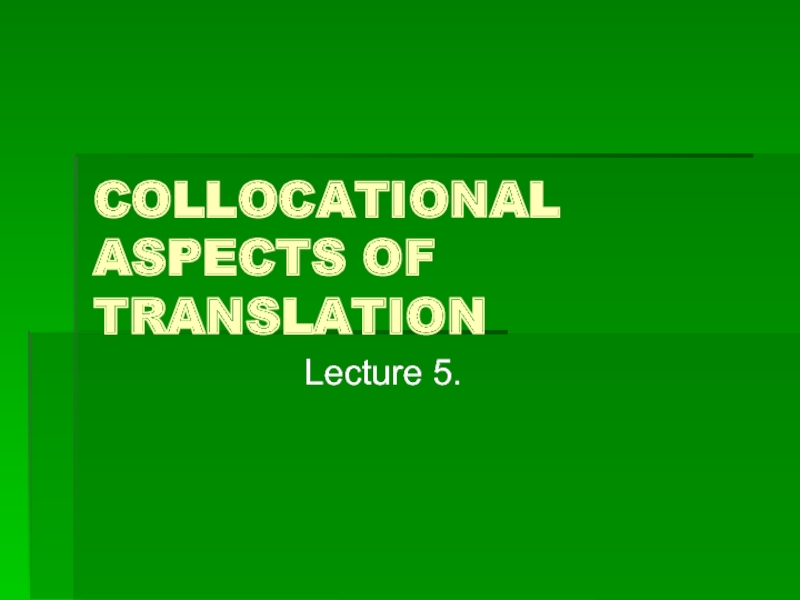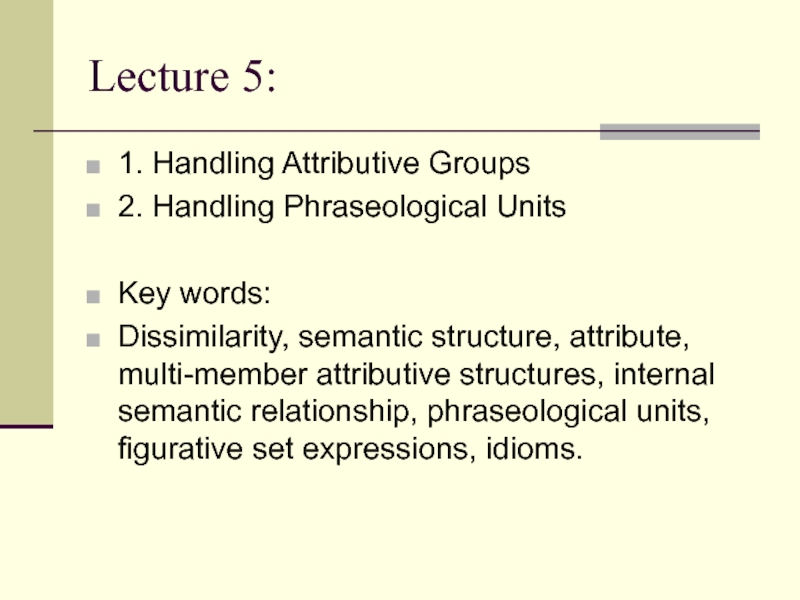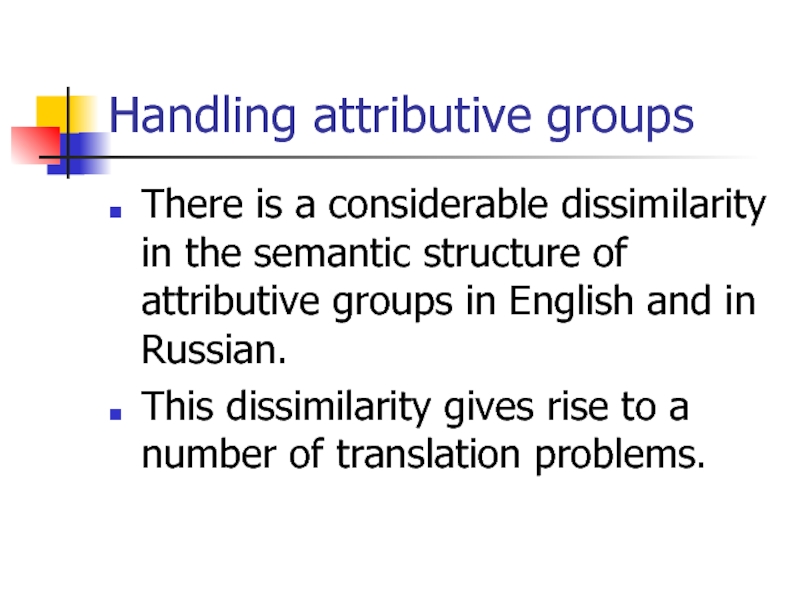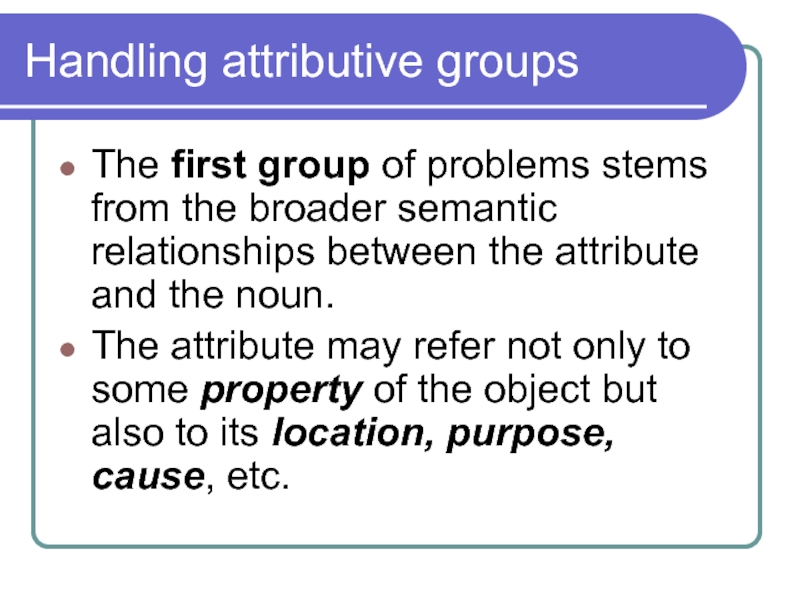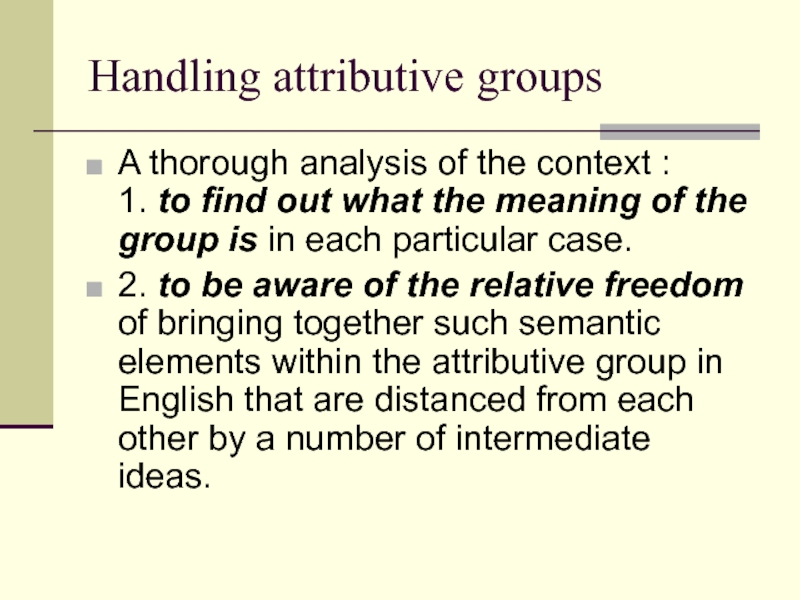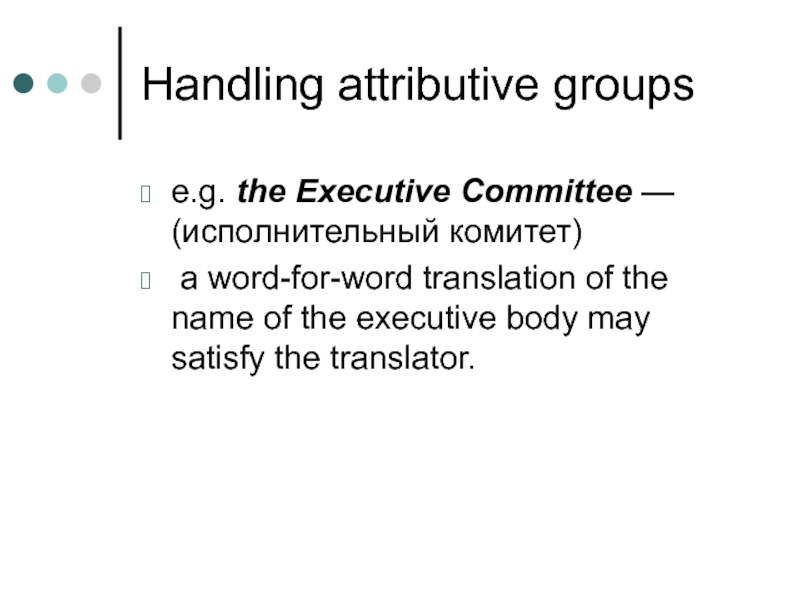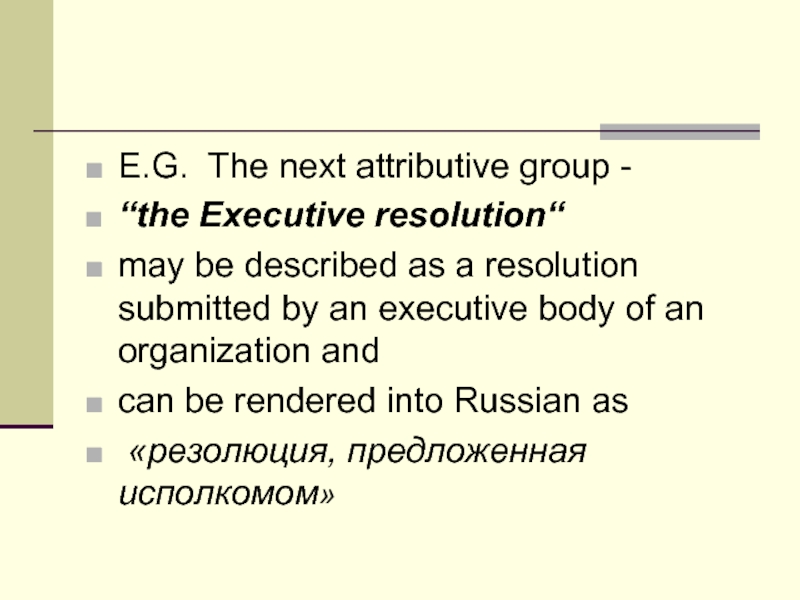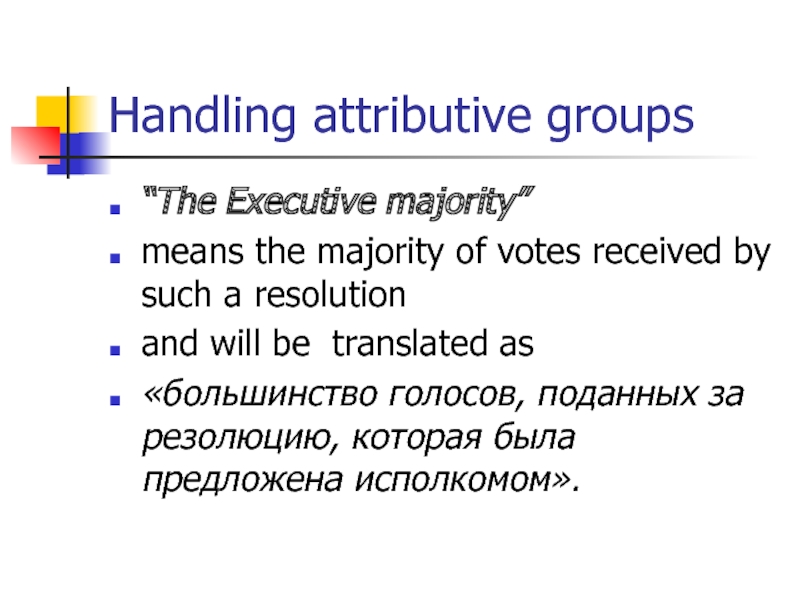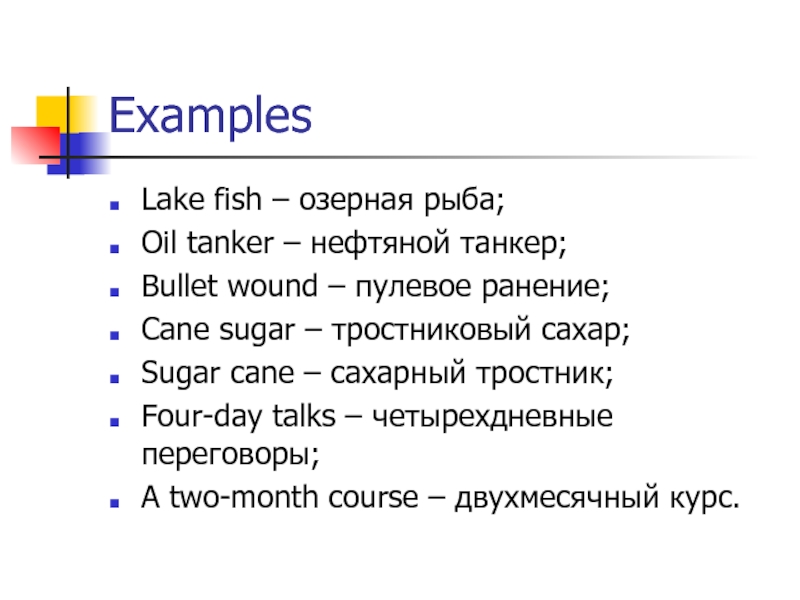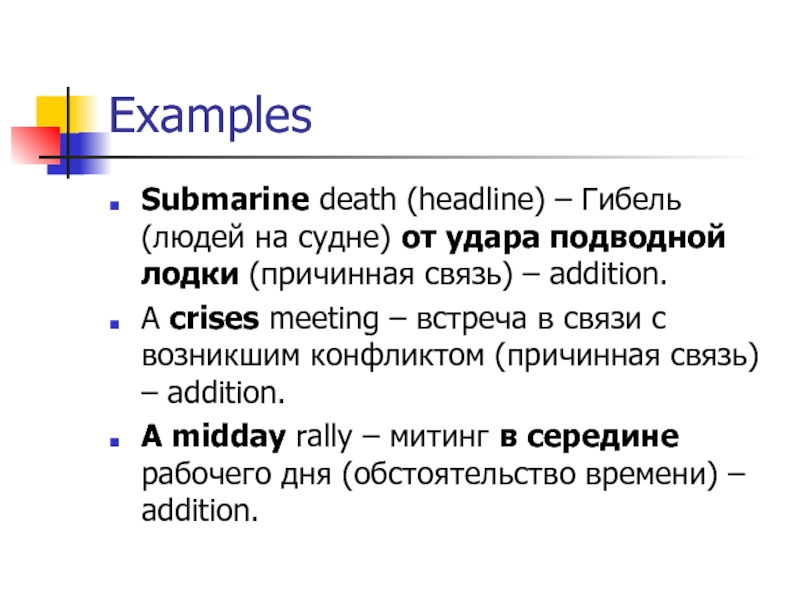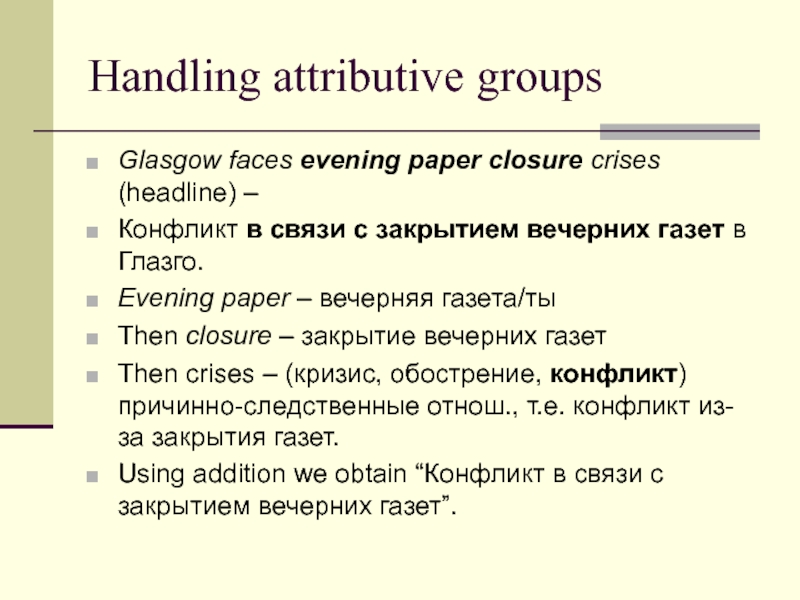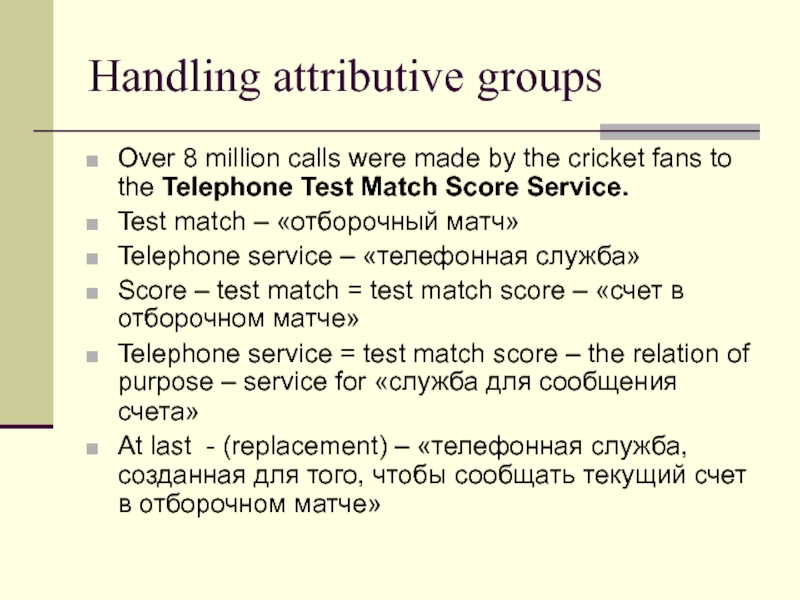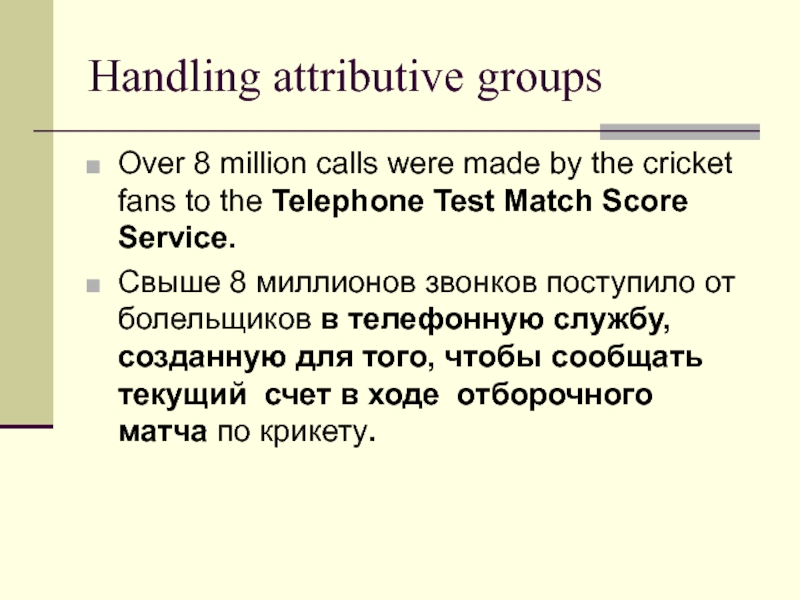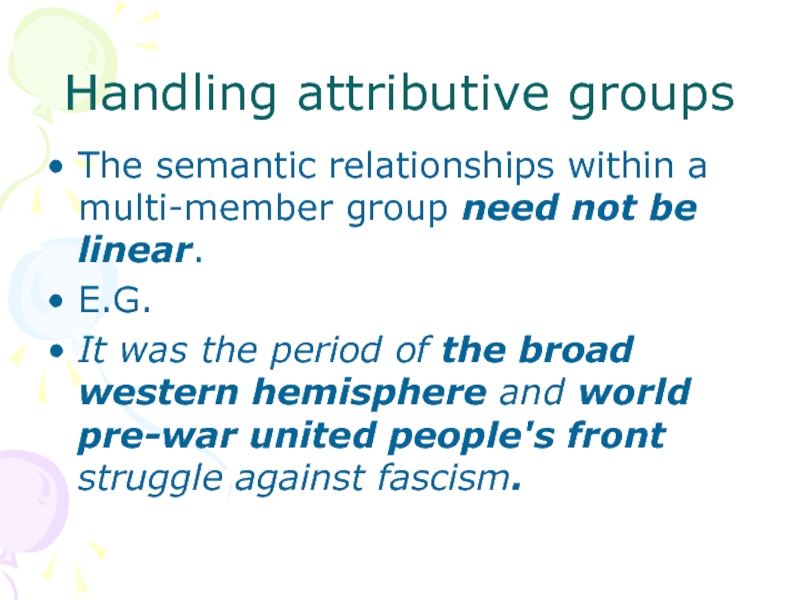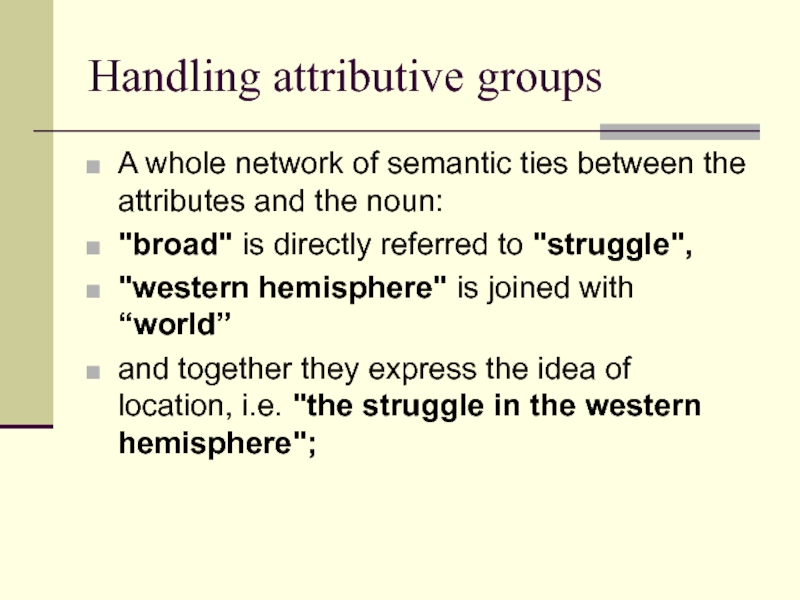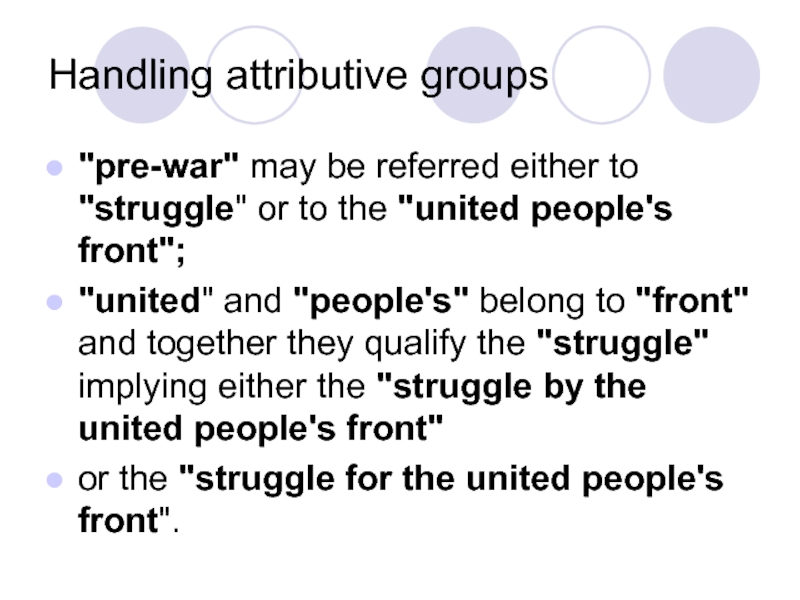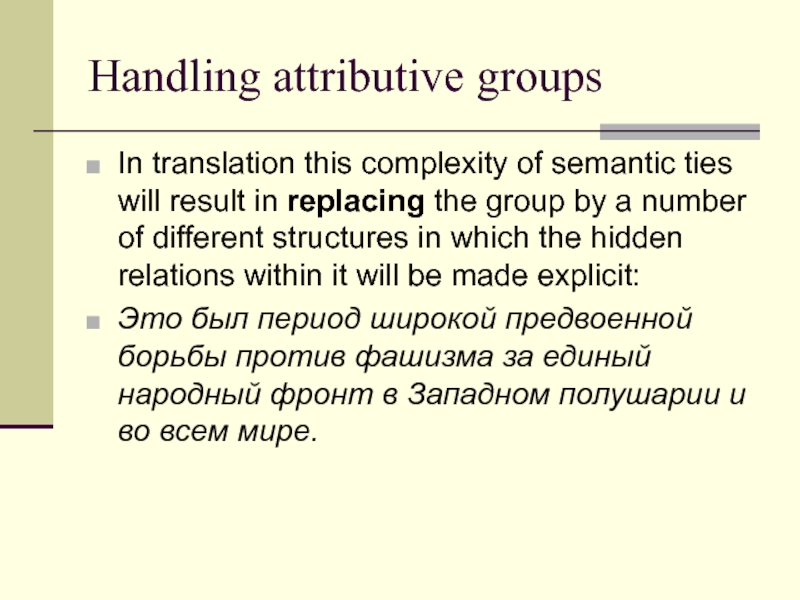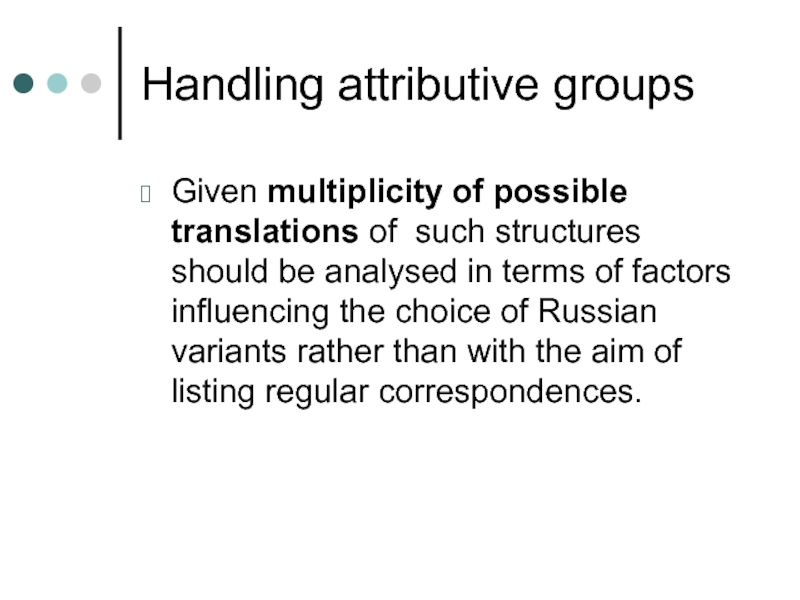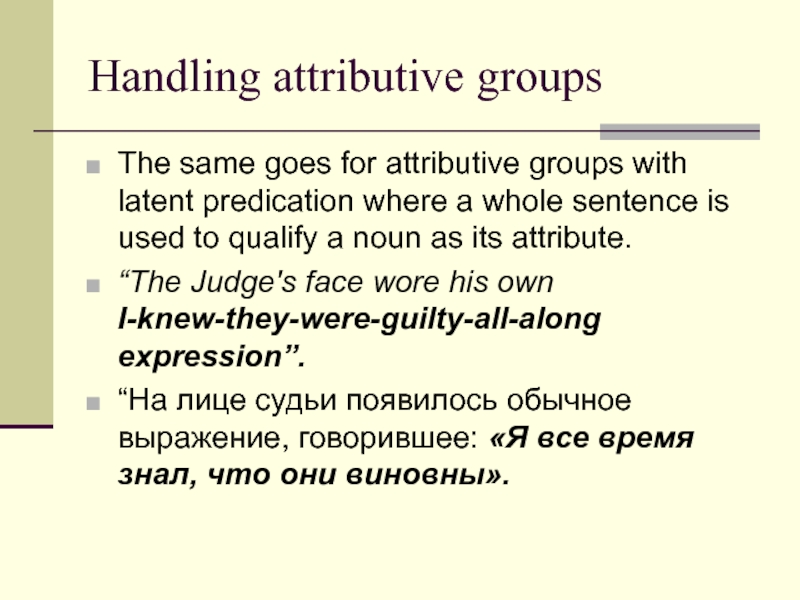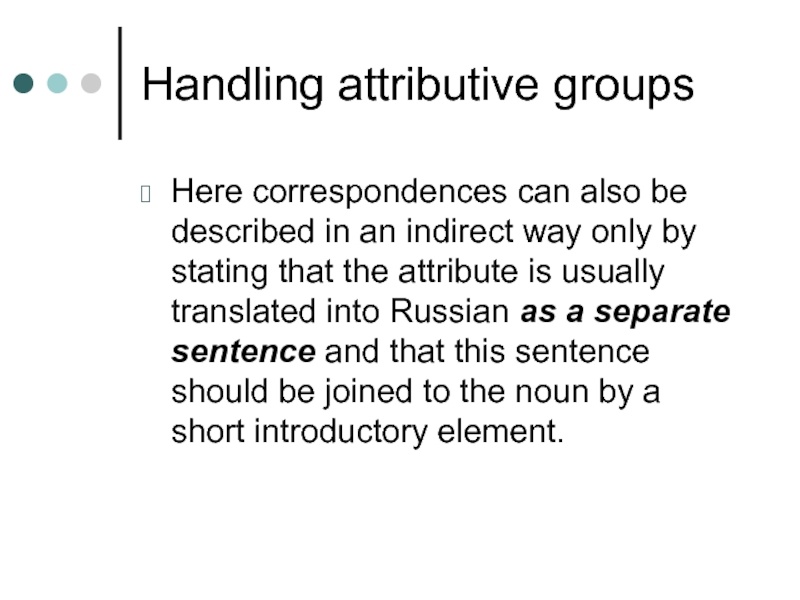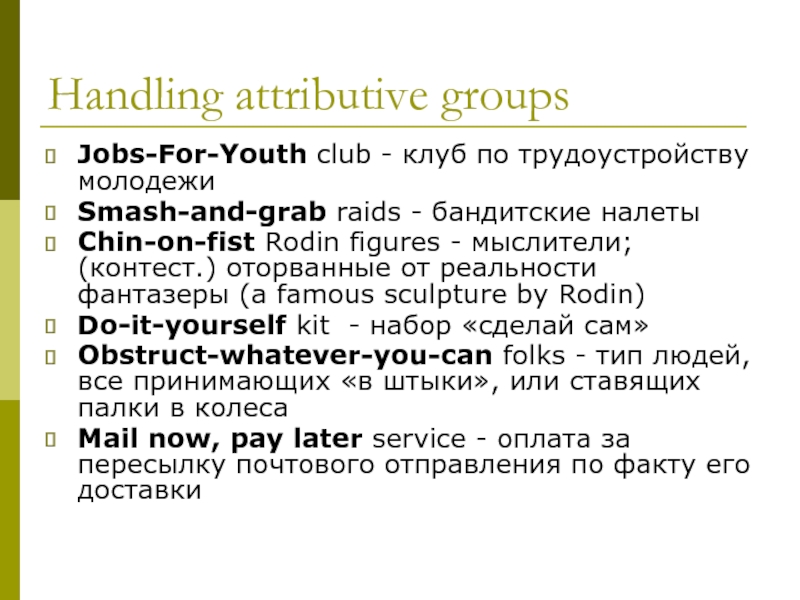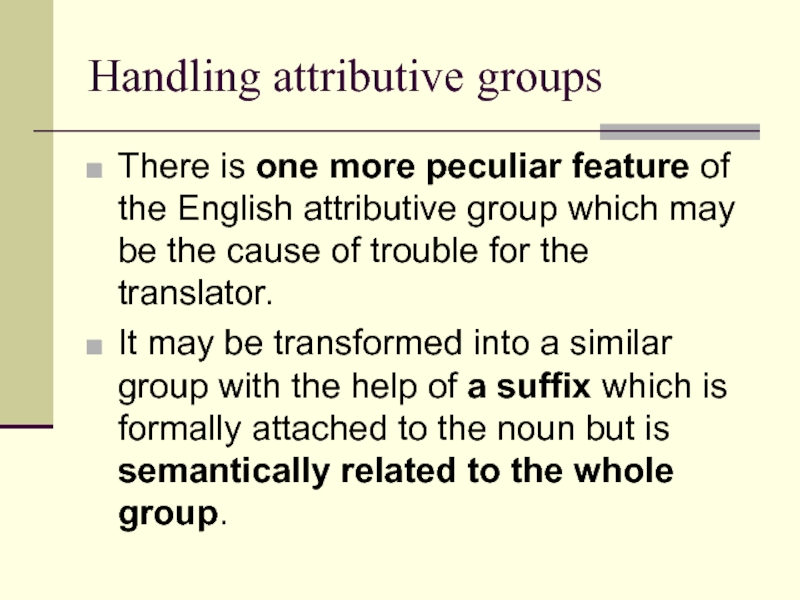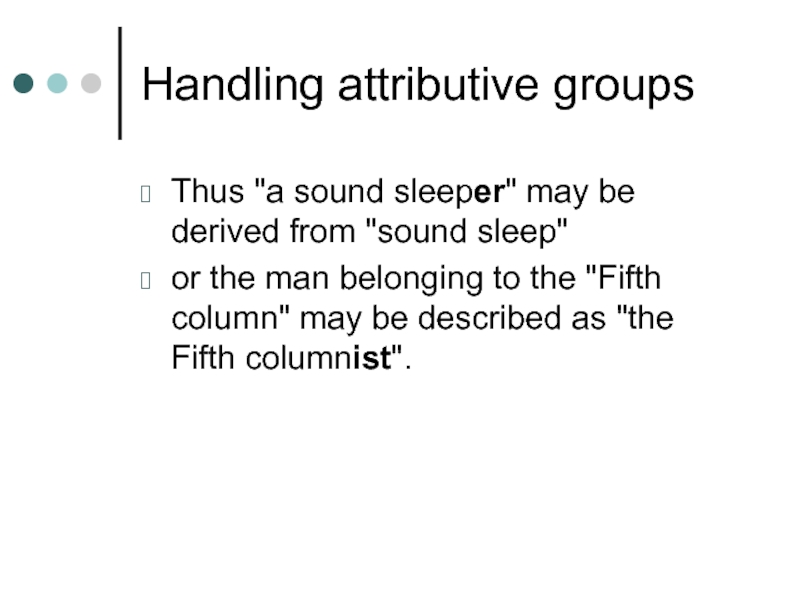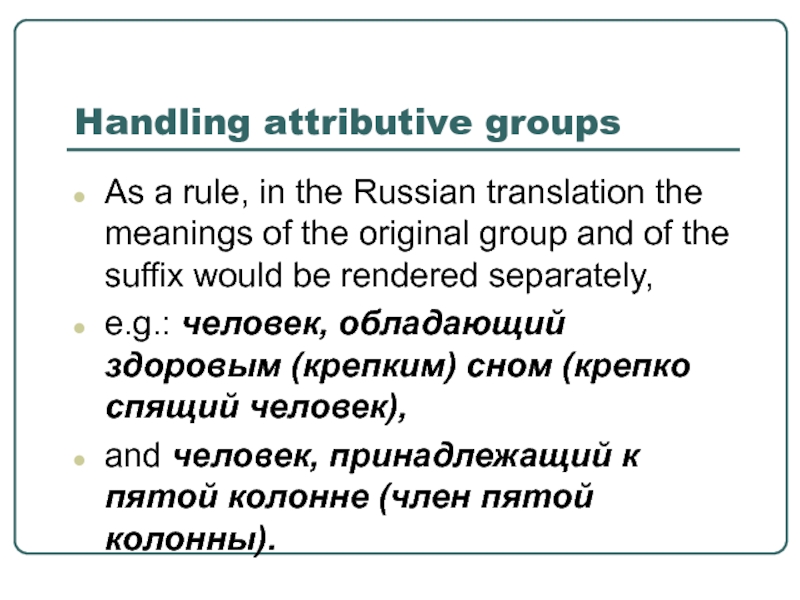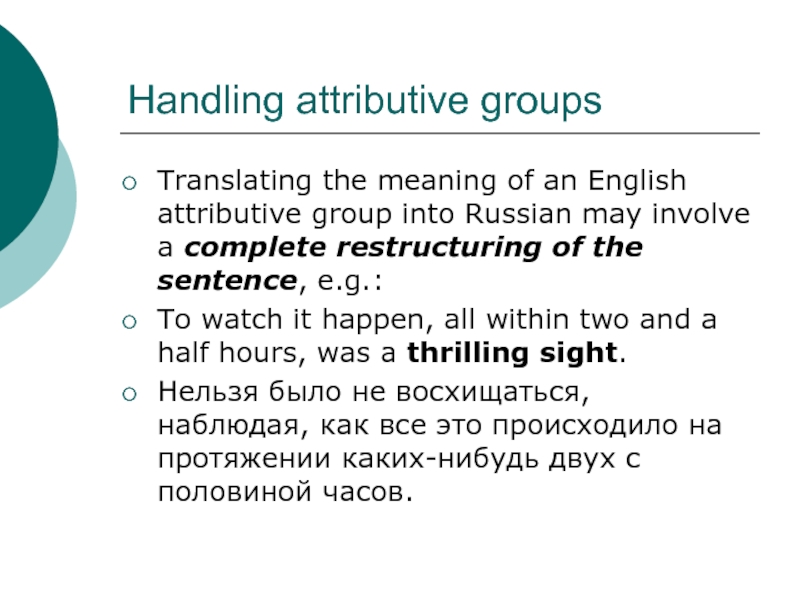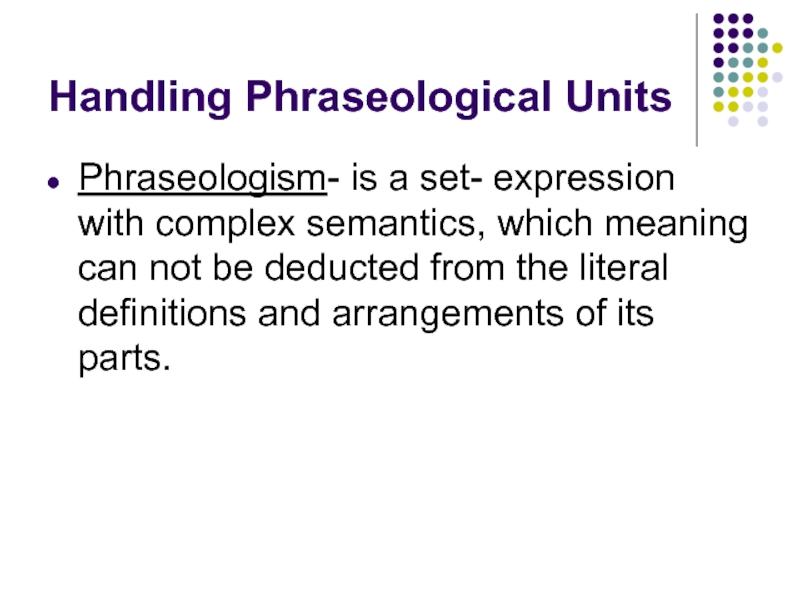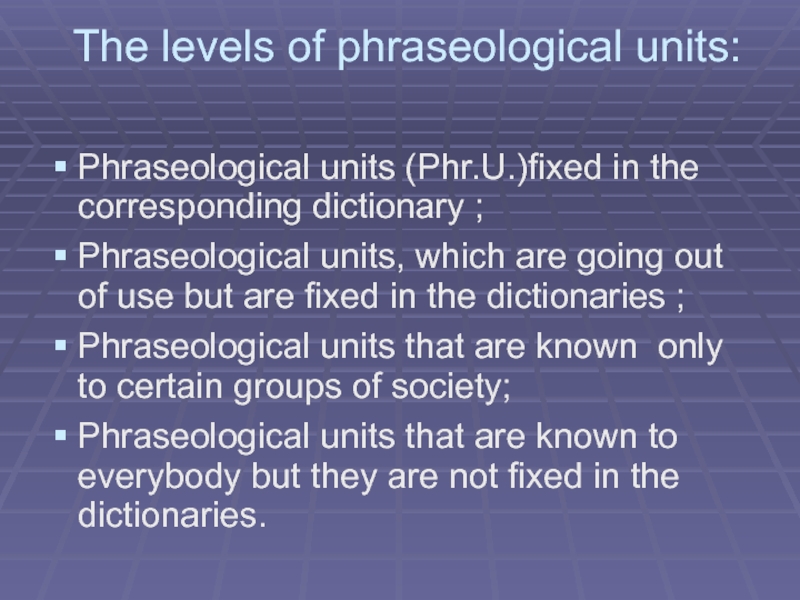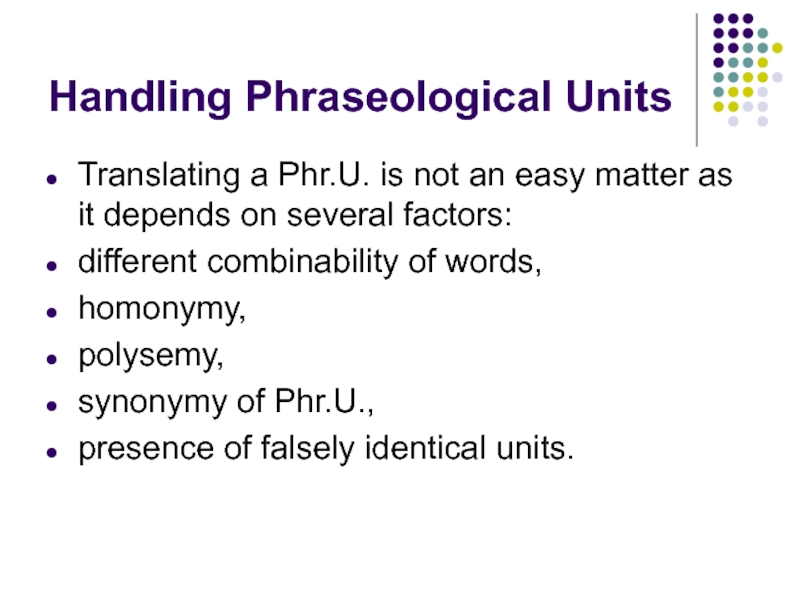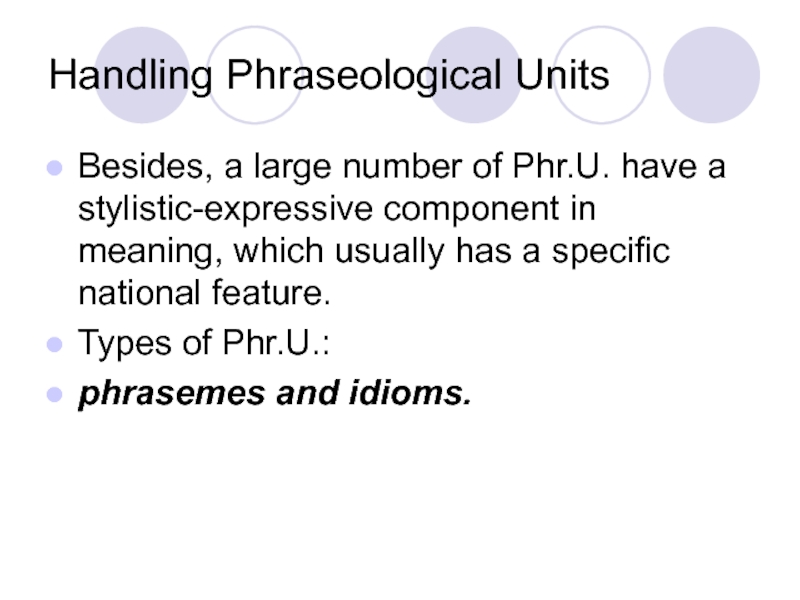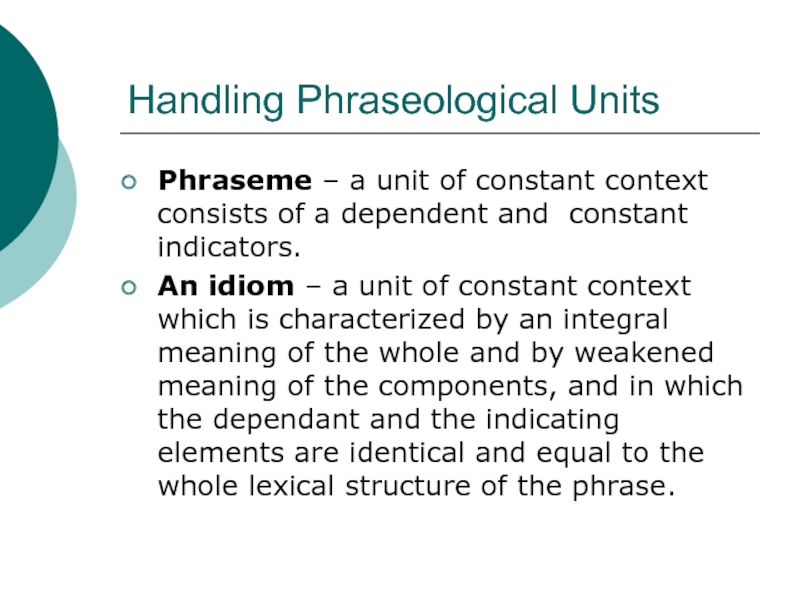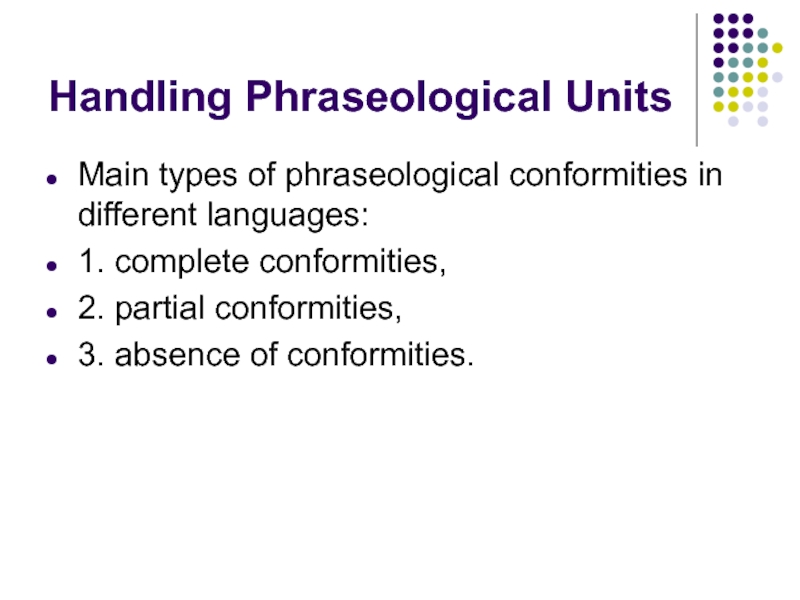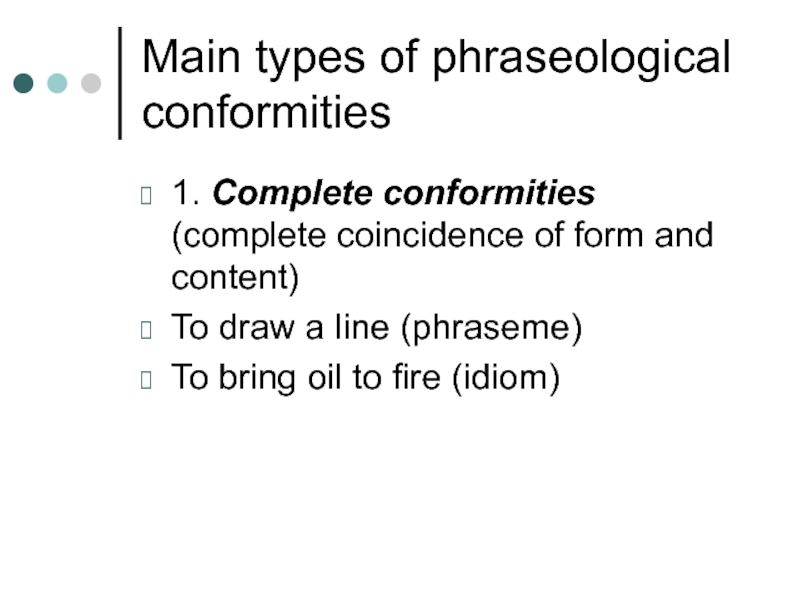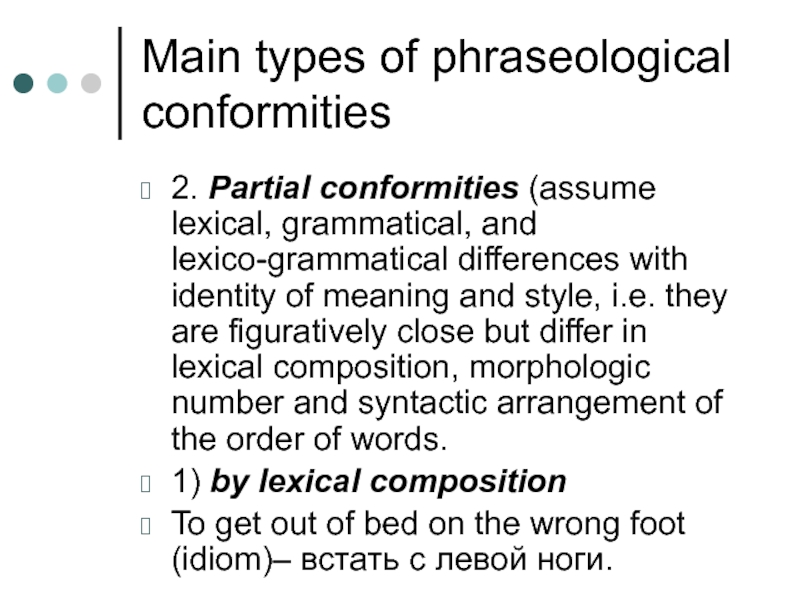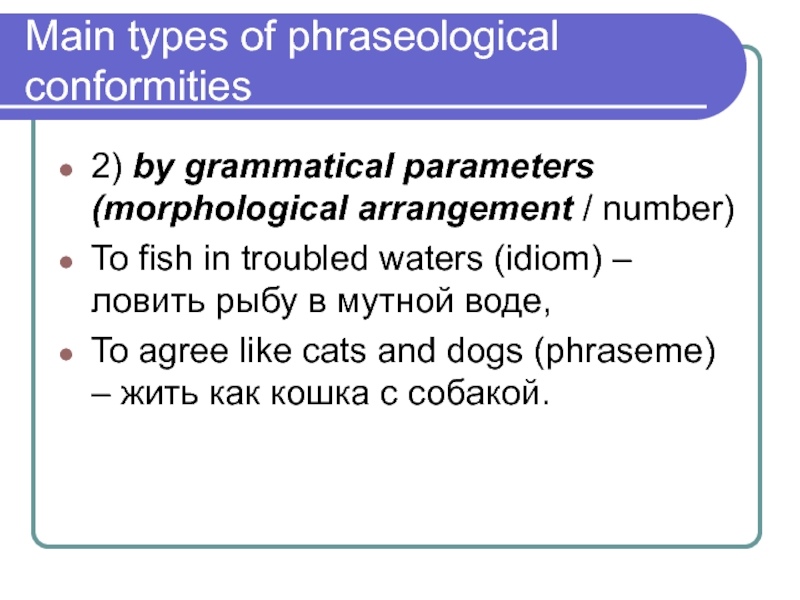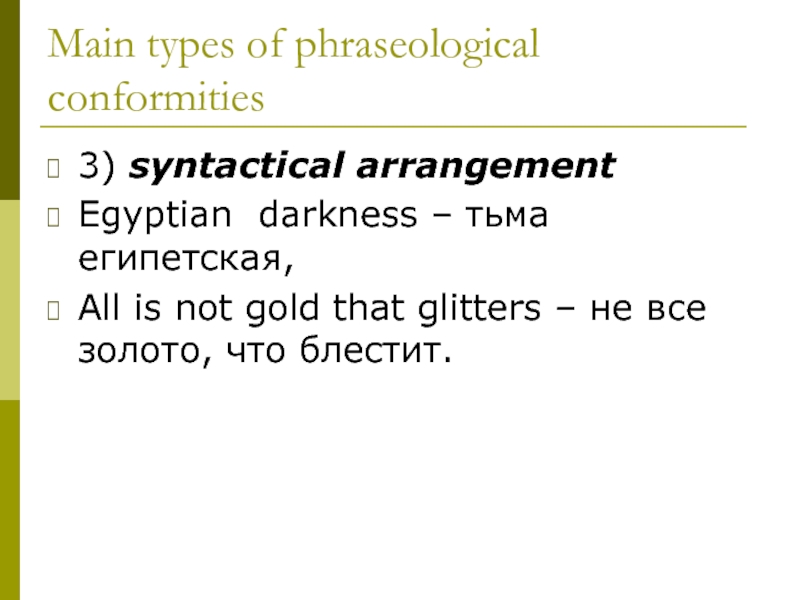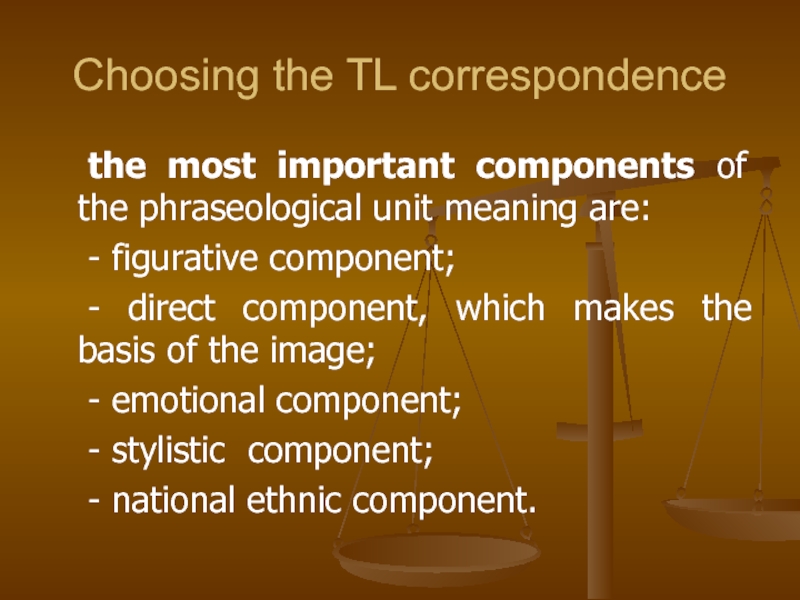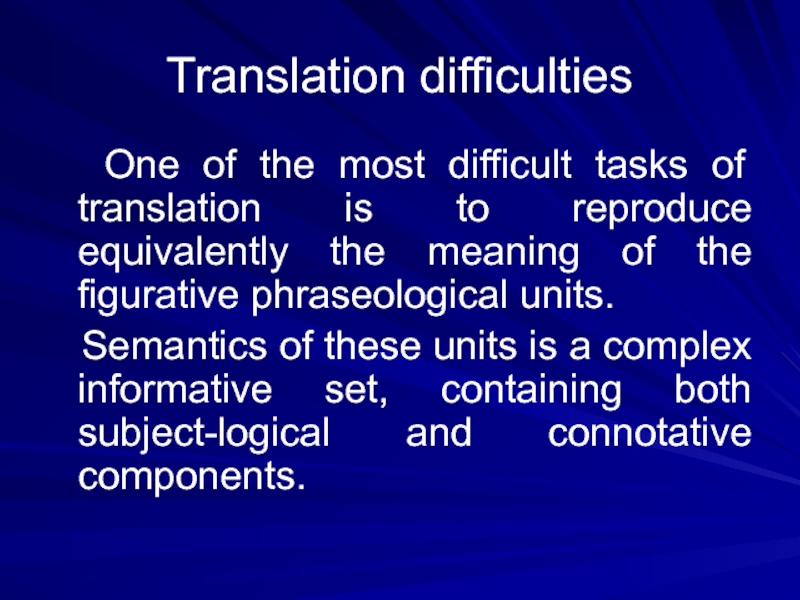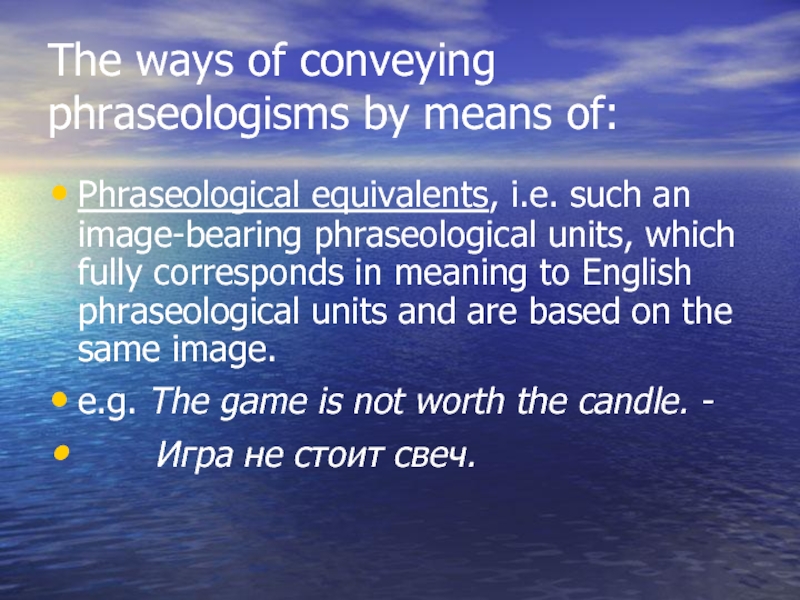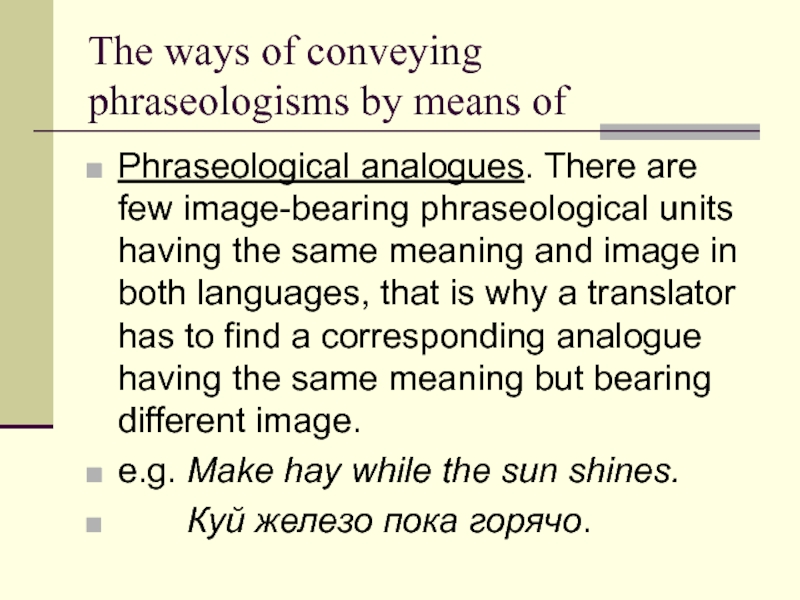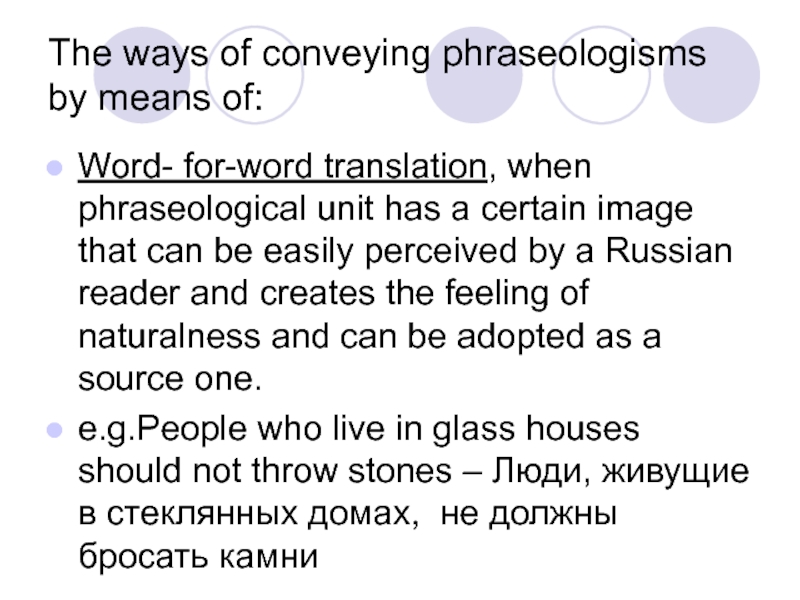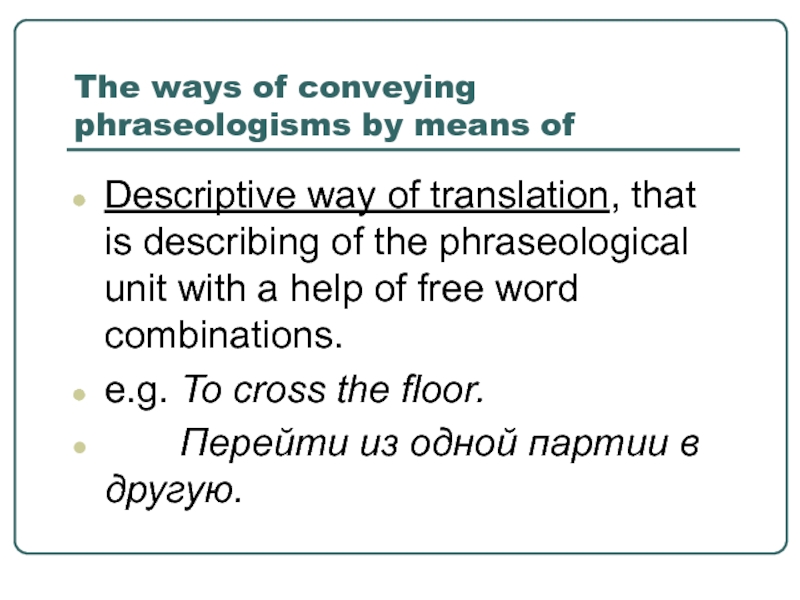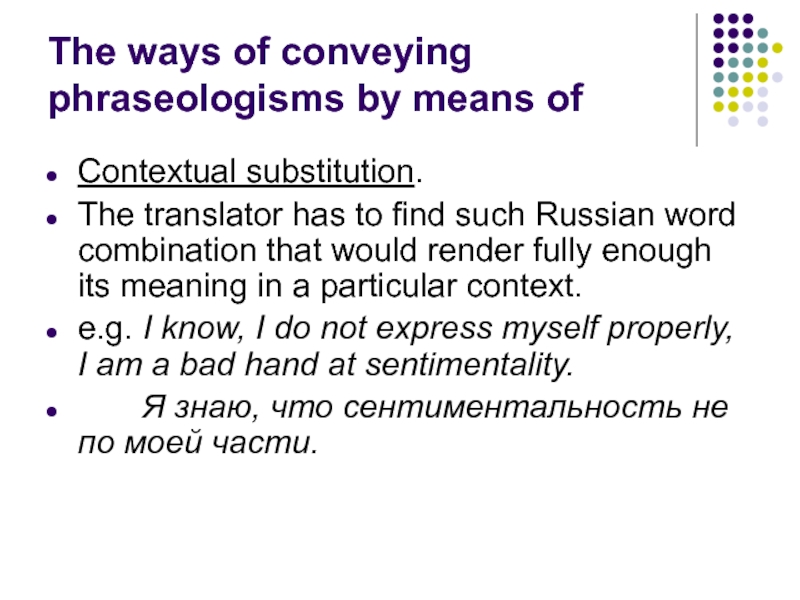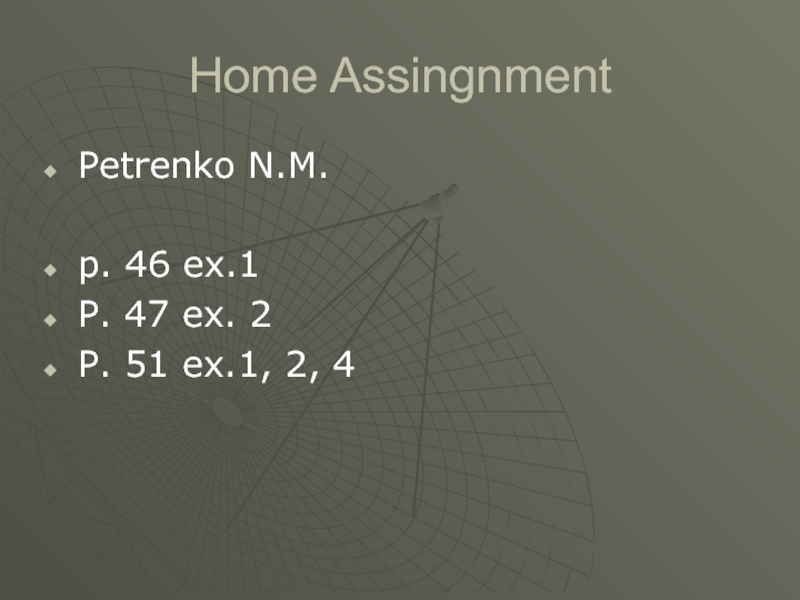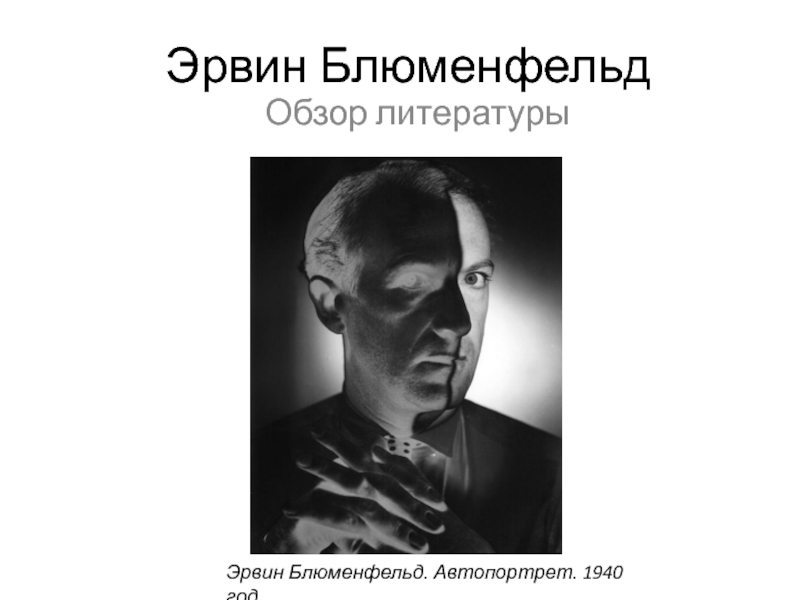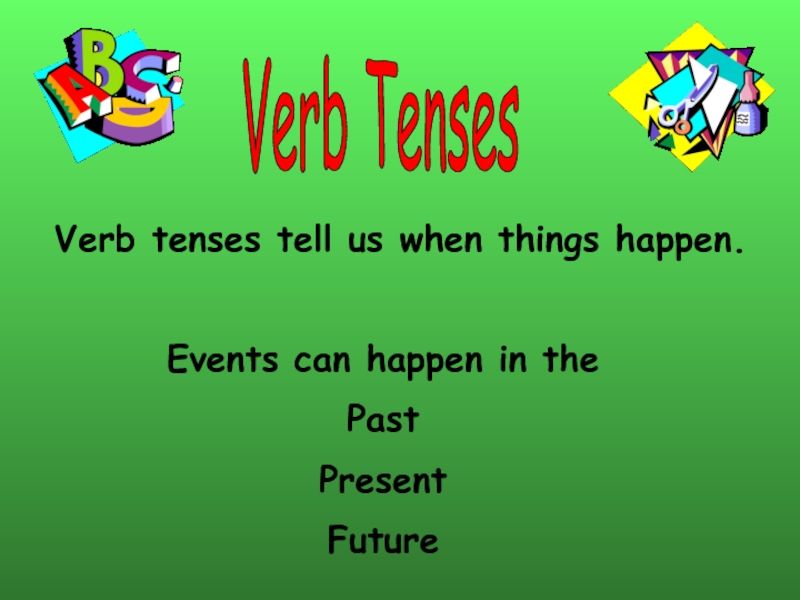- Главная
- Разное
- Дизайн
- Бизнес и предпринимательство
- Аналитика
- Образование
- Развлечения
- Красота и здоровье
- Финансы
- Государство
- Путешествия
- Спорт
- Недвижимость
- Армия
- Графика
- Культурология
- Еда и кулинария
- Лингвистика
- Английский язык
- Астрономия
- Алгебра
- Биология
- География
- Детские презентации
- Информатика
- История
- Литература
- Маркетинг
- Математика
- Медицина
- Менеджмент
- Музыка
- МХК
- Немецкий язык
- ОБЖ
- Обществознание
- Окружающий мир
- Педагогика
- Русский язык
- Технология
- Физика
- Философия
- Химия
- Шаблоны, картинки для презентаций
- Экология
- Экономика
- Юриспруденция
Collocational aspects of translation презентация
Содержание
- 1. Collocational aspects of translation
- 2. Lecture 5: 1. Handling Attributive Groups 2.
- 3. Handling attributive groups There is a considerable
- 4. Handling attributive groups The first group of
- 5. Handling attributive groups A thorough analysis of
- 6. Handling attributive groups e.g. the Executive Committee
- 7. E.G. The next attributive group
- 8. Handling attributive groups “The Executive majority”
- 9. Examples Lake fish – озерная рыба;
- 10. Examples Submarine death (headline) – Гибель
- 11. Handling attributive groups The second group of
- 12. Handling attributive groups The tax paid for
- 13. Handling attributive groups Glasgow faces evening paper
- 14. Handling attributive groups Over 8 million calls
- 15. Handling attributive groups Over 8 million calls
- 16. Handling attributive groups The semantic relationships within
- 17. Handling attributive groups A whole network of
- 18. Handling attributive groups "pre-war" may be referred
- 19. Handling attributive groups In translation this complexity
- 20. Handling attributive groups Given multiplicity of possible
- 21. Handling attributive groups The same goes for
- 22. Handling attributive groups Here correspondences can also
- 23. Handling attributive groups There was a man
- 24. Handling attributive groups Jobs-For-Youth club - клуб
- 25. Handling attributive groups There is one more
- 26. Handling attributive groups Thus "a sound sleeper"
- 27. Handling attributive groups As a rule, in
- 28. Handling attributive groups Translating the meaning of
- 29. Handling Phraseological Units Phraseologism- is a set-
- 30. The levels of phraseological units: Phraseological
- 31. Handling Phraseological Units Translating a Phr.U. is
- 32. Handling Phraseological Units Besides, a large number
- 33. Handling Phraseological Units Phraseme – a unit
- 34. Handling Phraseological Units Main types of phraseological
- 35. Main types of phraseological conformities 1. Complete
- 36. Main types of phraseological conformities 2. Partial
- 37. Main types of phraseological conformities 2) by
- 38. Main types of phraseological conformities 3) syntactical
- 39. Choosing the TL correspondence the most important
- 40. Translation difficulties One of the
- 41. The ways of conveying phraseologisms by means
- 42. The ways of conveying phraseologisms by means
- 43. The ways of conveying phraseologisms by means
- 44. The ways of conveying phraseologisms by means
- 45. The ways of conveying phraseologisms by means
- 46. Home Assingnment Petrenko N.M. p. 46
Слайд 2Lecture 5:
1. Handling Attributive Groups
2. Handling Phraseological Units
Key words:
Dissimilarity, semantic structure,
attribute, multi-member attributive structures, internal semantic relationship, phraseological units, figurative set expressions, idioms.
Слайд 3Handling attributive groups
There is a considerable dissimilarity in the semantic structure
of attributive groups in English and in Russian.
This dissimilarity gives rise to a number of translation problems.
This dissimilarity gives rise to a number of translation problems.
Слайд 4Handling attributive groups
The first group of problems stems from the broader
semantic relationships between the attribute and the noun.
The attribute may refer not only to some property of the object but also to its location, purpose, cause, etc.
The attribute may refer not only to some property of the object but also to its location, purpose, cause, etc.
Слайд 5Handling attributive groups
A thorough analysis of the context :
1. to find
out what the meaning of the group is in each particular case.
2. to be aware of the relative freedom of bringing together such semantic elements within the attributive group in English that are distanced from each other by a number of intermediate ideas.
2. to be aware of the relative freedom of bringing together such semantic elements within the attributive group in English that are distanced from each other by a number of intermediate ideas.
Слайд 6Handling attributive groups
e.g. the Executive Committee — (исполнительный комитет)
a
word-for-word translation of the name of the executive body may satisfy the translator.
Слайд 7
E.G. The next attributive group -
“the Executive resolution“
may
be described as a resolution submitted by an executive body of an organization and
can be rendered into Russian as
«резолюция, предложенная исполкомом»
can be rendered into Russian as
«резолюция, предложенная исполкомом»
Слайд 8Handling attributive groups
“The Executive majority”
means the majority of votes received
by such a resolution
and will be translated as
«большинство голосов, поданных за резолюцию, которая была предложена исполкомом».
and will be translated as
«большинство голосов, поданных за резолюцию, которая была предложена исполкомом».
Слайд 9Examples
Lake fish – озерная рыба;
Oil tanker – нефтяной танкер;
Bullet wound
– пулевое ранение;
Cane sugar – тростниковый сахар;
Sugar cane – сахарный тростник;
Four-day talks – четырехдневные переговоры;
A two-month course – двухмесячный курс.
Cane sugar – тростниковый сахар;
Sugar cane – сахарный тростник;
Four-day talks – четырехдневные переговоры;
A two-month course – двухмесячный курс.
Слайд 10Examples
Submarine death (headline) – Гибель (людей на судне) от удара
подводной лодки (причинная связь) – addition.
A crises meeting – встреча в связи с возникшим конфликтом (причинная связь) – addition.
A midday rally – митинг в середине рабочего дня (обстоятельство времени) – addition.
A crises meeting – встреча в связи с возникшим конфликтом (причинная связь) – addition.
A midday rally – митинг в середине рабочего дня (обстоятельство времени) – addition.
Слайд 11Handling attributive groups
The second group of problems results from the difficulties
in handling multi-member attributive structures.
The English-speaking people make a wide use of "multi-storied" structures with complicated internal semantic relationships.
The English-speaking people make a wide use of "multi-storied" structures with complicated internal semantic relationships.
Слайд 12Handling attributive groups
The tax paid for the right to take part
in the election is described as "the poll tax".
The states where this tax is collected are "the poll tax states" and the governors of these states are "the poll tax states governors".
Now these governors may hold a conference which will be referred to as “the poll tax states governors conference" and so on.
The states where this tax is collected are "the poll tax states" and the governors of these states are "the poll tax states governors".
Now these governors may hold a conference which will be referred to as “the poll tax states governors conference" and so on.
Слайд 13Handling attributive groups
Glasgow faces evening paper closure crises (headline) –
Конфликт
в связи с закрытием вечерних газет в Глазго.
Evening paper – вечерняя газета/ты
Then closure – закрытие вечерних газет
Then crises – (кризис, обострение, конфликт) причинно-следственные отнош., т.е. конфликт из-за закрытия газет.
Using addition we obtain “Конфликт в связи с закрытием вечерних газет”.
Evening paper – вечерняя газета/ты
Then closure – закрытие вечерних газет
Then crises – (кризис, обострение, конфликт) причинно-следственные отнош., т.е. конфликт из-за закрытия газет.
Using addition we obtain “Конфликт в связи с закрытием вечерних газет”.
Слайд 14Handling attributive groups
Over 8 million calls were made by the cricket
fans to the Telephone Test Match Score Service.
Test match – «отборочный матч»
Telephone service – «телефонная служба»
Score – test match = test match score – «счет в отборочном матче»
Telephone service = test match score – the relation of purpose – service for «служба для сообщения счета»
At last - (replacement) – «телефонная служба, созданная для того, чтобы сообщать текущий счет в отборочном матче»
Test match – «отборочный матч»
Telephone service – «телефонная служба»
Score – test match = test match score – «счет в отборочном матче»
Telephone service = test match score – the relation of purpose – service for «служба для сообщения счета»
At last - (replacement) – «телефонная служба, созданная для того, чтобы сообщать текущий счет в отборочном матче»
Слайд 15Handling attributive groups
Over 8 million calls were made by the cricket
fans to the Telephone Test Match Score Service.
Свыше 8 миллионов звонков поступило от болельщиков в телефонную службу, созданную для того, чтобы сообщать текущий счет в ходе отборочного матча по крикету.
Свыше 8 миллионов звонков поступило от болельщиков в телефонную службу, созданную для того, чтобы сообщать текущий счет в ходе отборочного матча по крикету.
Слайд 16Handling attributive groups
The semantic relationships within a multi-member group need not
be linear.
E.G.
It was the period of the broad western hemisphere and world pre-war united people's front struggle against fascism.
E.G.
It was the period of the broad western hemisphere and world pre-war united people's front struggle against fascism.
Слайд 17Handling attributive groups
A whole network of semantic ties between the attributes
and the noun:
"broad" is directly referred to "struggle",
"western hemisphere" is joined with “world”
and together they express the idea of location, i.e. "the struggle in the western hemisphere";
"broad" is directly referred to "struggle",
"western hemisphere" is joined with “world”
and together they express the idea of location, i.e. "the struggle in the western hemisphere";
Слайд 18Handling attributive groups
"pre-war" may be referred either to "struggle" or to
the "united people's front";
"united" and "people's" belong to "front" and together they qualify the "struggle" implying either the "struggle by the united people's front"
or the "struggle for the united people's front".
"united" and "people's" belong to "front" and together they qualify the "struggle" implying either the "struggle by the united people's front"
or the "struggle for the united people's front".
Слайд 19Handling attributive groups
In translation this complexity of semantic ties will result
in replacing the group by a number of different structures in which the hidden relations within it will be made explicit:
Это был период широкой предвоенной борьбы против фашизма за единый народный фронт в Западном полушарии и во всем мире.
Это был период широкой предвоенной борьбы против фашизма за единый народный фронт в Западном полушарии и во всем мире.
Слайд 20Handling attributive groups
Given multiplicity of possible translations of such structures should
be analysed in terms of factors influencing the choice of Russian variants rather than with the aim of listing regular correspondences.
Слайд 21Handling attributive groups
The same goes for attributive groups with latent predication
where a whole sentence is used to qualify a noun as its attribute.
“The Judge's face wore his own I-knew-they-were-guilty-all-along expression”.
“На лице судьи появилось обычное выражение, говорившее: «Я все время знал, что они виновны».
“The Judge's face wore his own I-knew-they-were-guilty-all-along expression”.
“На лице судьи появилось обычное выражение, говорившее: «Я все время знал, что они виновны».
Слайд 22Handling attributive groups
Here correspondences can also be described in an indirect
way only by stating that the attribute is usually translated into Russian as a separate sentence and that this sentence should be joined to the noun by a short introductory element.
Слайд 23Handling attributive groups
There was a man with a don't-say-anything-to-me-or-I'll-contradict-you face. (Ch.
Dickens)
Там был человек, на лице которого было написано: что бы вы мне ни говорили, я все равно буду вам противоречить.
Там был человек, на лице которого было написано: что бы вы мне ни говорили, я все равно буду вам противоречить.
Слайд 24Handling attributive groups
Jobs-For-Youth club - клуб по трудоустройству молодежи
Smash-and-grab raids -
бандитские налеты
Chin-on-fist Rodin figures - мыслители; (контест.) оторванные от реальности фантазеры (a famous sculpture by Rodin)
Do-it-yourself kit - набор «сделай сам»
Obstruct-whatever-you-can folks - тип людей, все принимающих «в штыки», или ставящих палки в колеса
Mail now, pay later service - оплата за пересылку почтового отправления по факту его доставки
Chin-on-fist Rodin figures - мыслители; (контест.) оторванные от реальности фантазеры (a famous sculpture by Rodin)
Do-it-yourself kit - набор «сделай сам»
Obstruct-whatever-you-can folks - тип людей, все принимающих «в штыки», или ставящих палки в колеса
Mail now, pay later service - оплата за пересылку почтового отправления по факту его доставки
Слайд 25Handling attributive groups
There is one more peculiar feature of the English
attributive group which may be the cause of trouble for the translator.
It may be transformed into a similar group with the help of a suffix which is formally attached to the noun but is semantically related to the whole group.
It may be transformed into a similar group with the help of a suffix which is formally attached to the noun but is semantically related to the whole group.
Слайд 26Handling attributive groups
Thus "a sound sleeper" may be derived from "sound
sleep"
or the man belonging to the "Fifth column" may be described as "the Fifth columnist".
or the man belonging to the "Fifth column" may be described as "the Fifth columnist".
Слайд 27Handling attributive groups
As a rule, in the Russian translation the meanings
of the original group and of the suffix would be rendered separately,
e.g.: человек, обладающий здоровым (крепким) сном (крепко спящий человек),
and человек, принадлежащий к пятой колонне (член пятой колонны).
e.g.: человек, обладающий здоровым (крепким) сном (крепко спящий человек),
and человек, принадлежащий к пятой колонне (член пятой колонны).
Слайд 28Handling attributive groups
Translating the meaning of an English attributive group into
Russian may involve a complete restructuring of the sentence, e.g.:
To watch it happen, all within two and a half hours, was a thrilling sight.
Нельзя было не восхищаться, наблюдая, как все это происходило на протяжении каких-нибудь двух с половиной часов.
To watch it happen, all within two and a half hours, was a thrilling sight.
Нельзя было не восхищаться, наблюдая, как все это происходило на протяжении каких-нибудь двух с половиной часов.
Слайд 29Handling Phraseological Units
Phraseologism- is a set- expression with complex semantics, which
meaning can not be deducted from the literal definitions and arrangements of its parts.
Слайд 30The levels of phraseological units:
Phraseological units (Phr.U.)fixed in the corresponding dictionary
;
Phraseological units, which are going out of use but are fixed in the dictionaries ;
Phraseological units that are known only to certain groups of society;
Phraseological units that are known to everybody but they are not fixed in the dictionaries.
Phraseological units, which are going out of use but are fixed in the dictionaries ;
Phraseological units that are known only to certain groups of society;
Phraseological units that are known to everybody but they are not fixed in the dictionaries.
Слайд 31Handling Phraseological Units
Translating a Phr.U. is not an easy matter as
it depends on several factors:
different combinability of words,
homonymy,
polysemy,
synonymy of Phr.U.,
presence of falsely identical units.
different combinability of words,
homonymy,
polysemy,
synonymy of Phr.U.,
presence of falsely identical units.
Слайд 32Handling Phraseological Units
Besides, a large number of Phr.U. have a stylistic-expressive
component in meaning, which usually has a specific national feature.
Types of Phr.U.:
phrasemes and idioms.
Types of Phr.U.:
phrasemes and idioms.
Слайд 33Handling Phraseological Units
Phraseme – a unit of constant context consists of
a dependent and constant indicators.
An idiom – a unit of constant context which is characterized by an integral meaning of the whole and by weakened meaning of the components, and in which the dependant and the indicating elements are identical and equal to the whole lexical structure of the phrase.
An idiom – a unit of constant context which is characterized by an integral meaning of the whole and by weakened meaning of the components, and in which the dependant and the indicating elements are identical and equal to the whole lexical structure of the phrase.
Слайд 34Handling Phraseological Units
Main types of phraseological conformities in different languages:
1. complete
conformities,
2. partial conformities,
3. absence of conformities.
2. partial conformities,
3. absence of conformities.
Слайд 35Main types of phraseological conformities
1. Complete conformities (complete coincidence of form
and content)
To draw a line (phraseme)
To bring oil to fire (idiom)
To draw a line (phraseme)
To bring oil to fire (idiom)
Слайд 36Main types of phraseological conformities
2. Partial conformities (assume lexical, grammatical, and
lexico-grammatical differences with identity of meaning and style, i.e. they are figuratively close but differ in lexical composition, morphologic number and syntactic arrangement of the order of words.
1) by lexical composition
To get out of bed on the wrong foot (idiom)– встать с левой ноги.
1) by lexical composition
To get out of bed on the wrong foot (idiom)– встать с левой ноги.
Слайд 37Main types of phraseological conformities
2) by grammatical parameters (morphological arrangement /
number)
To fish in troubled waters (idiom) – ловить рыбу в мутной воде,
To agree like cats and dogs (phraseme) – жить как кошка с собакой.
To fish in troubled waters (idiom) – ловить рыбу в мутной воде,
To agree like cats and dogs (phraseme) – жить как кошка с собакой.
Слайд 38Main types of phraseological conformities
3) syntactical arrangement
Egyptian darkness – тьма египетская,
All
is not gold that glitters – не все золото, что блестит.
Слайд 39Choosing the TL correspondence
the most important components of the phraseological unit
meaning are:
- figurative component;
- direct component, which makes the basis of the image;
- emotional component;
- stylistic component;
- national ethnic component.
- figurative component;
- direct component, which makes the basis of the image;
- emotional component;
- stylistic component;
- national ethnic component.
Слайд 40Translation difficulties
One of the most difficult tasks of translation
is to reproduce equivalently the meaning of the figurative phraseological units.
Semantics of these units is a complex informative set, containing both subject-logical and connotative components.
Semantics of these units is a complex informative set, containing both subject-logical and connotative components.
Слайд 41The ways of conveying phraseologisms by means of:
Phraseological equivalents, i.e. such
an image-bearing phraseological units, which fully corresponds in meaning to English phraseological units and are based on the same image.
e.g. The game is not worth the candle. -
Игра не стоит свеч.
e.g. The game is not worth the candle. -
Игра не стоит свеч.
Слайд 42The ways of conveying phraseologisms by means of
Phraseological analogues. There are
few image-bearing phraseological units having the same meaning and image in both languages, that is why a translator has to find a corresponding analogue having the same meaning but bearing different image.
e.g. Make hay while the sun shines.
Куй железо пока горячо.
e.g. Make hay while the sun shines.
Куй железо пока горячо.
Слайд 43The ways of conveying phraseologisms by means of:
Word- for-word translation, when
phraseological unit has a certain image that can be easily perceived by a Russian reader and creates the feeling of naturalness and can be adopted as a source one.
e.g.People who live in glass houses should not throw stones – Люди, живущие в стеклянных домах, не должны бросать камни
e.g.People who live in glass houses should not throw stones – Люди, живущие в стеклянных домах, не должны бросать камни
Слайд 44The ways of conveying phraseologisms by means of
Descriptive way of translation,
that is describing of the phraseological unit with a help of free word combinations.
e.g. To cross the floor.
Перейти из одной партии в другую.
e.g. To cross the floor.
Перейти из одной партии в другую.
Слайд 45The ways of conveying phraseologisms by means of
Contextual substitution.
The translator
has to find such Russian word combination that would render fully enough its meaning in a particular context.
e.g. I know, I do not express myself properly, I am a bad hand at sentimentality.
Я знаю, что сентиментальность не по моей части.
e.g. I know, I do not express myself properly, I am a bad hand at sentimentality.
Я знаю, что сентиментальность не по моей части.
